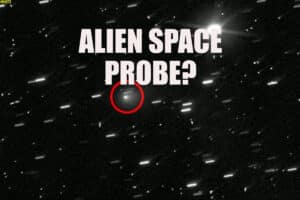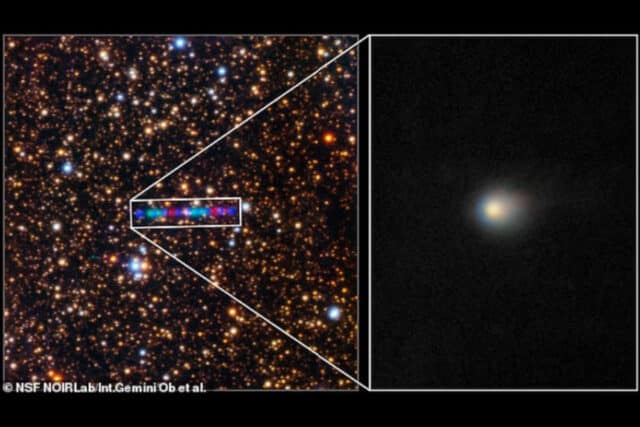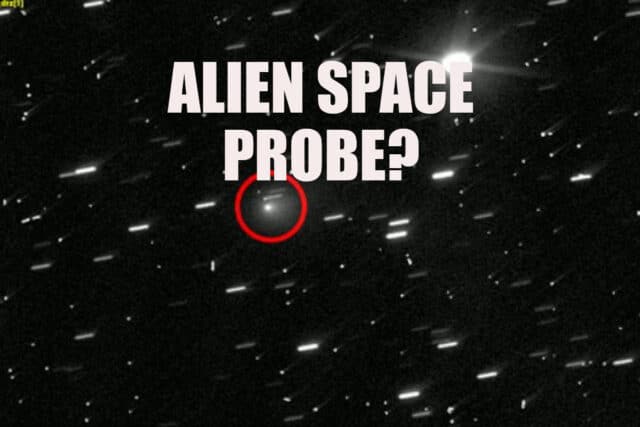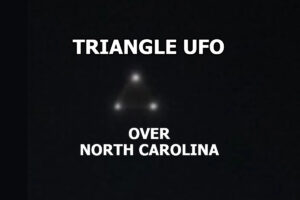
Is an alien space probe headed towards Earth?
A massive shadow streaks across the vast emptiness of space. It’s 3I/ATLAS, a colossal interstellar object hurtling toward our solar system. Discovered on July 1, 2025, by the ATLAS telescope in Chile, this enigmatic traveler has sparked wild curiosity. What if it’s not just a rock, but something engineered by distant minds?
Astronomers spotted it veering toward the Sun at over 130,000 miles per hour. That’s faster than anything we’ve seen from beyond our stars. Initial observations hint at a comet-like body, roughly 15 miles wide—bigger than Manhattan. But its path and quirks have some wondering: Could this be a sign of extraterrestrial life?
Harvard astronomer Avi Loeb, known for bold ideas, co-authored a paper on July 16, 2025, pondering if 3I/ATLAS is alien technology. He stresses it’s likely natural, but the “what if” pulls us in. Imagine advanced beings sending a probe our way. The paper, uploaded to arXiv, calls it a “pedagogical exercise” to stretch our thinking.
The object shows a cloudy coma of ice, gas, and dust, stretching up to 15 miles across. It might hold water ice trapped for billions of years, older than our solar system. Yet, anomalies like non-gravitational acceleration without clear outgassing raise eyebrows.
What if this visitor carries secrets from another world? Loeb’s work invites us to ponder without jumping to conclusions.
Key Takeaways
- 3I/ATLAS is the third detected interstellar object, speeding through our solar system with unusual traits that spark alien probe theories.
- Harvard’s Avi Loeb highlights its trajectory as potentially beneficial for extraterrestrial intelligence, per his recent paper.
- Links to ‘Oumuamua remind us of past interstellar mysteries, urging open-minded exploration.
- While likely a natural comet, the “what if” scenario encourages scientific vigilance.
Never Miss A Paranormal Story!
Newsletter subscribers get insider access to the latest paranormal posts!
Your email is safe with us and you can unsubscribe at any time!
What Is 3I/ATLAS?
Picture a giant icy body tumbling through the void.
3I/ATLAS is an interstellar object, meaning it originates from outside our solar system. It’s only the third such visitor we’ve confirmed.
NASA announced its discovery on July 1, 2025. The ATLAS survey in Chile first caught it as a faint blip, moving at tremendous speed.
Early data suggests it’s a comet. It has a coma—a hazy envelope of sublimating ice and dust.
But its size stands out. Estimates put it at about 15 miles in diameter. That’s larger than New York City’s Manhattan borough.
It contains water ice, possibly mixed with organic molecules, silicates, and carbon-based minerals. Some models hint it could be up to 3 billion years older than our solar system.
One puzzling feature: significant non-gravitational acceleration. Normally, comets speed up from outgassing jets. Here, that’s missing.
No spectral fingerprints of carbon-based molecules appear, odd for a comet.
What if these quirks point to something more?

Its Mysterious Origins
Where does 3I/ATLAS come from? That’s the big question.
Interstellar objects like this get ejected from distant star systems. Gravitational tugs from planets or stars fling them into the galaxy.
3I/ATLAS likely wandered the Milky Way for eons before entering our neighborhood.
It crossed the outer solar system boundaries around 8,000 years ago, based on its speed.
Now, it’s inbound. It will pass near Jupiter, Mars, and Venus.
Its path takes it close to the Sun in late October 2025. Then, it hides on the Sun’s far side from Earth.
By November or December, it could swing nearer to our planet.
Too fast for our rockets to catch—our best reach only a third of its velocity.
What if this origin story hides a crafted journey?

Why Some Think It Might Be an Alien Ship
The idea thrills the imagination. What if 3I/ATLAS is no random rock, but a probe from afar?
Avi Loeb and colleagues propose this in their paper. They note its “very unlikely combination of characteristics.”
First, the trajectory. It enters at a higher speed and unusual angle than past visitors.
Loeb says, “The orbital path of 3I/ATLAS has some very unlikely combination of characteristics, which could quite easily have been simple coincidence, as extremely strange as that ostensibly appears.”
Its low retrograde tilt makes interception tough for us, but easy access to key planets.
“Loeb further posits that this tilt and trajectory could allow any intelligent life aboard the object to gather ‘astrometric measurements’ to ascertain the orbits and masses of the planets within our Solar System, thereby enabling the formulation of an optimal strategy for entering the Solar System.” (Note: This is a paraphrase in source, but aligns with paper.)
The paper invokes the “Dark Forest” hypothesis. Advanced civilizations might stay silent, viewing others as threats.
What if 3I/ATLAS is surveillance gear, disguised as a comet?
Its perihelion hides it from Earth telescopes when brightest.
Loeb notes, “This could be intentional to avoid detailed observations from Earth-based telescopes when the object is brightest or when gadgets are sent to Earth from that hidden vantage point.”
The non-gravitational push without outgassing? Maybe thrusters.
“One of the ‘most puzzling’ observations is that the object has ‘significant ‘non-gravitational’ acceleration whilst having now ‘cometary outgassing,’” per the paper.
Its size and lack of volatiles add to the mystery.
Loeb asks, “If 3I/ATLAS is not an asteroid — based on the interstellar reservoir argument in my paper, nor a comet — based on the lack of the spectral fingerprints of carbon-based molecules around it, then what is it?”
The paper suggests it could be a “technological artifact” with intelligence, benign or malign.
“The consequences, should the [dark forest] hypothesis turn out to be correct, could potentially be dire for humanity, and would possibly require defensive measures to be undertaken (though these might prove futile.)”
What if it’s braking for a closer look at Earth and Jupiter?
Loeb advocates tests: Check for comet tail, electrostatic discharge, or radio signals.
The “what if” opens doors to exciting possibilities.
The Everyday Explanation
Of course, not everyone sees aliens.
Many experts view 3I/ATLAS as a plain comet.
It shows “classical signatures of cometary activity,” like the coma.
Darryl Seligman says, “There have been numerous telescopic observations of 3I/ATLAS demonstrating that it’s displaying classical signatures of cometary activity.”
No volatiles yet? It’s still far from the Sun.
Seligman adds, “The object is still pretty far away from the sun, so no, we wouldn’t typically expect to find direct evidence of volatiles necessarily.”
Samantha Lawler states, “All evidence points to this being an ordinary comet that was ejected from another solar system, just as countless billions of comets have been ejected from our own solar system.”
Loeb himself agrees: “By far the most likely outcome will be that 3I/ATLAS is a completely natural interstellar object, probably a comet.”
The anomalies? Coincidences in a vast universe.
Echoes of ‘Oumuamua
This isn’t the first time.
In 2017, ‘Oumuamua zipped through—a cigar-shaped rock, the first interstellar object detected.
Loeb suggested it might be an alien probe, due to its odd shape and unexplained acceleration.
Consensus leaned toward a gas-leaking asteroid, comet-like.
But Loeb wrote a book on its possible alien origins.
3I/ATLAS echoes that debate. It’s faster, larger, with similar quirks.
What if these visitors are scouts?
The parallels fuel ongoing curiosity about cosmic neighbors.
Wrapping Up the Mystery
3I/ATLAS is still a long ways out, but approaching fast. Will it turn out to be just another space rock or will we get a very big surprise and have it hit the brakes to stop and say hello, or something worse?
For now time will tell. As a skeptical believer, my money is on it being an odd rock from a distant part of this big crazy universe. But the fact that this is the second really odd space rock to do a fly-by has me wondering if instead of just stopping to do some anal probes or mess with some cows, the aliens have brought the whole family over for a visit.











